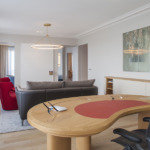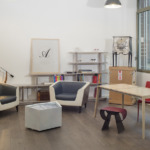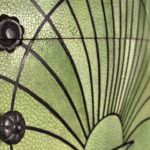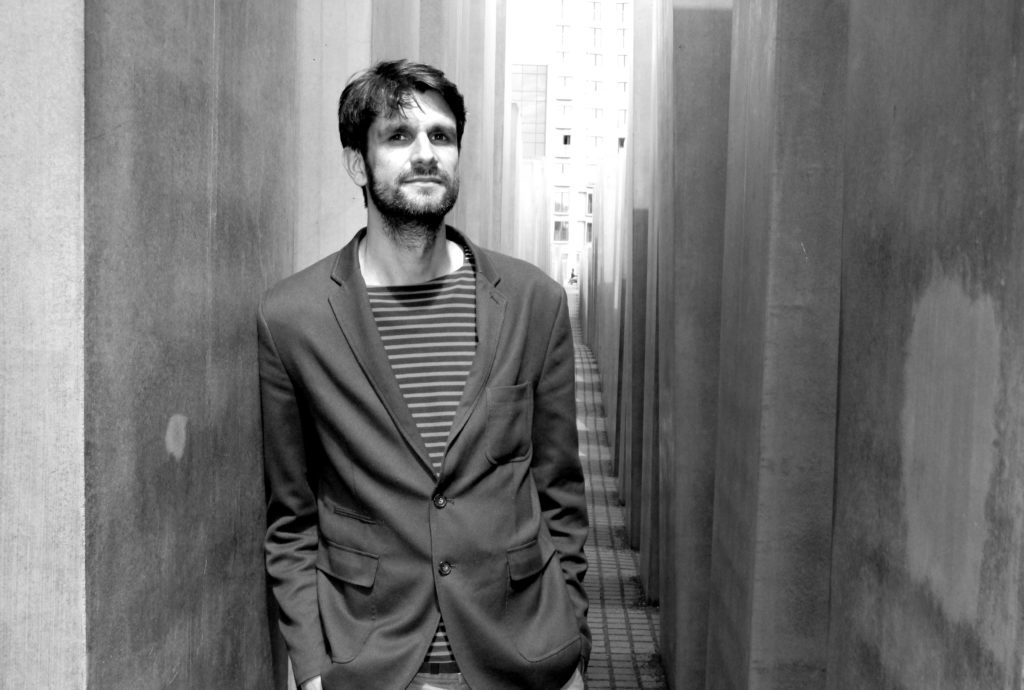By Fanny Revault
Ludovic Avenel, cabinetmaker – designer, combines design and tradition, creativity and know – how with virtuosity since 2008, to create unique pieces of furniture. Always on the lookout for the “beautiful”, he continues to evolve his creations. Going beyond the functional aspect of an object, these pieces awaken, surprise and magnify the places to live. Meeting with a lover of nature, materials and spaces.
How do you practice cabinetmaking – designer?
I do the job of cabinetmaker in a rather transversal way. From creation, design to manufacturing, the fields of activity in which I work are quite broad. This can be in the field of art since I draw and make pieces that I sell directly in gallery. I also make tailor-made for all other creatives who need a particular skill. It can be a creative accompaniment on the design or manufacture. I also make partnerships with other craftsmen, artists, designers and interior designers. I practice cabinetmaking. But sometimes I also handle glass, metal or copper. I finally feel like a “maker”, I think it’s the most appropriate word … I like to go from idea to realization and accompany others in this process.
Your main line of research: innovation?
My main focus is to innovate by trying to re-read what has been done, understand it and use these new technologies that offer a wide range of technical and aesthetic innovations. A new tool, a new machine inevitably makes it possible to create a new interesting language to implement in the design, for materials and certain projects.
Do you revisit old creations?
I was fortunate to be able to perform a reinterpretation work, a few years ago, on a small chest of Paul Iribe and Clément Rousseau that fascinated me because it was very innovative for the time. She was shaggy. Today, it may seem past but it was a real innovation. His creative process came from the fact that Paul Iribe had discovered particular materials with which it was possible to make furniture coatings. I wanted to copy this piece because it was fascinating for the time and posed a real technical challenge. The interest of this approach is that by doing, I wondered how Paul Iribe would have made this piece if he had been alive. Not from an aesthetic point of view since it was art deco but was inspired by an eighteenth time in its form, but from the point of view of the materials.
The idea just came to me today, we are in a problems of materials, recycling and durability. Following this, I thought that Paul Iribe could have made this dresser with recycled materials, paper, cardboard rubber … Finally, what I had fun to show is that the two pieces are similar on the formal level, but radically different from the materials used. Creation does not only lie in the form but also in the transformation of a material or in the choice of materials.
This search for new materials led you to innovate a “soft wood”?
What I also love in my job is the innovation that we can have through words. I like this creative association between words that sometimes have nothing to do. Making stitched wood, soft, crooked, wrinkled … What I find interesting is that a material can take the shape of another … In my opinion, the interest of wood is to give it a dimension that can have a fabric. The soft wood can be sewn, zipped, buttoned … It fascinated me because I was able to see many things from the angle of flexibility. For example, I could open a door in a flexible way, I could make a desktop that glitters allowing access to an interior storage, which gave life to the “desk to be stripped”. There would be many other possible applications with this material that opens an aesthetic vocabulary and allows technical innovations in use.
Your approach, the “slow made”?
What I find interesting in the “slow made” is that it is a movement inspired by “slow food” in Italy. The principle is simply to take the necessary time. Today, in our trades, we have a process of manufacture necessarily linked to the fact that the tree takes so many years to grow, to dry and that it takes a certain duration to manufacture an object … In this acceleration of time and sometimes in this shortening of time – it often happens to me to have orders that were for yesterday or for yesterday – it is simply necessary to have the time to do well, to produce quality, to take pleasure but also to ensure a form of durability in the manufactured object. If we want the latter to last, we have to make it with certain rules, and these rules take time … To highlight this, the “slow-made” movement aims to bring together a certain number of artisans, designers and artists so that they can talk about the time they need to work.
Your creations… high-end products?
What I realize comes without wanting in the criteria of luxury because, inevitably, I do things that take a while to be manufactured, with materials that can sometimes be expensive. Fatally, I arrive on sales prices quite substantial. In this way, I enter a universe that can be called “luxury”. This is one of the criteria. But others concern the typology of objects, the universe in which they fit because they are responses to amenities where shops, hotels that are themselves in criteria concerning the high-end and the quality. It is to this extent that I subscribe to luxury. But today, I think the true value of luxury is this notion of the time it takes to do it right. It would be interesting to democratize this time, it is much more accessible than it is now … And my main regret is to make pieces that are not accessible to all.
For you, what is a masterpiece?
For me, it’s something almost unachievable … But it’s interesting, it’s the quest in which we registered each time we realize a project. It requires to arrive at the top of a kind of pyramid. The goal is to achieve a sort of quintessence, a piece that does not need any additions or withdrawals.
If you ask someone who makes a building, such as the cathedral builders, the first question you can ask a craftsman who breaks rocks is what he does. The first craftsman replies that he breaks a stone, the second that he builds a wall and the third responds that he builds a cathedral. If wisdom presides over the construction of a building, one can almost go towards a form of masterpiece or fulfillment of something “perfect”. Because there will have been a desire to go beyond the only physical piece with a much more precise sense, humanistic or symbolic. For me, it brings together so many parameters that it seems to me very difficult to achieve the masterpiece.
Why is art important in our lives?
I have the impression that we are constantly trying to reproduce what nature does in an incredible way. When I look at a landscape, a flower, a scale of the micro to macrocosm, I think everything is beautiful. I do not want to touch anything but just contemplate …
When I, human, do something, I am constantly in judgment, in modifying, in seeking that masterpiece of which we were speaking at the moment and which is difficult to attain. Indeed, perhaps what we are doing is not natural. It may be an extension … One probably tries to recreate a divine act, a form of pure creation. I believe that this is where creation exists, to give pleasure to meaning and bring well-being. In my opinion, the most beautiful thing that is most accomplished in terms of design and art is nature.


Ludovic Avenel

Ludovic Avenel

Ludovic Avenel

Ludovic Avenel

Ludovic Avenel

Ludovic Avenel

Ludovic Avenel

Ludovic Avenel

Ludovic Avenel

Ludovic Avenel

Ludovic Avenel

Ludovic Avenel

Ludovic Avenel

Ludovic Avenel

Ludovic Avenel

Ludovic Avenel

Ludovic Avenel

Ludovic Avenel



















